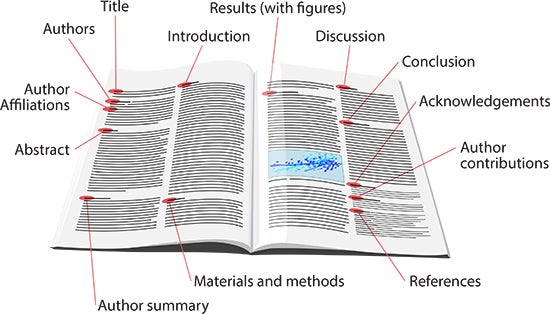Before you can search for, write about, or incorporate an article into your research, you need to understand it.
However, do not plan to read a scholarly or scientific journal article the same way you would a book or a magazine article. This section focuses on identifying the elements of the scholarly article and offers recommended steps for reading them.
A research article is a primary source, meaning that it reports on original research done by the authors of the article. Research articles normally include the following parts:
A review article is a secondary source, meaning that it discusses other articles and doesn't report original research. Review articles are a great way to get an overview of the research being done.
Types of Sources
Periodicals = anything that is published on a regular (periodic) basis.
Periodicals can be broken down into groups, such as:
newspapers (usually published daily)
popular magazines (often published weekly or monthly)
scholarly journals (usually published monthly, every other month, quarterly, or twice a year)
Scholarly journals
are focused on an academic discipline such as history or nursing
are usually written by and for scholars, researchers, and professionals
include lengthy articles that often describe research studies
are usually peer-reviewed, which means a group of scholars review articles before they are published in the journal
are not flashy and don't usually include photos and advertisements
Popular magazines
are usually written by journalists for the general public
include articles that are often short and cover a wide range of topics
are flashy, glossy, and include many photos and advertisements in order to attract attention
Scholarly articles are written by researchers or experts in a field in order to share the results of their original research or analysis with other researchers and students. These articles often go through a process known as peer review where the article is reviewed by a group of experts in the field.
It’s not always easy to tell if an article has been peer-reviewed. Some databases will help by labeling results scholarly or academic. However, you will still need to examine each article to be sure that it’s scholarly.

Research papers generally follow a specific format. Here are the different parts of the scholarly article.
Abstract (Summary)
The abstract, generally written by the author(s) of the article, provides a concise summary of the whole article. Usually it highlights the focus, study results and conclusion(s) of the article.
Introduction (Why)
In this section, the authors introduce their topic, explain the purpose of the study, and present why it is important, unique or how it adds to existing knowledge in their field. Look for the author's hypothesis or thesis here.
Introduction - Literature Review (Who else)
Many scholarly articles include a summary of previous research or discussions published on this topic, called a "Literature Review". This section outlines what others have found and what questions still remain.
Methodology / Materials and Methods (How)
Find the details of how the study was performed in this section. There should be enough specifics so that you could repeat the study if you wanted.
Results (What happened)
This section includes the findings from the study. Look for the data and statistical results in the form of tables, charts, and graphs. Some papers include an analysis here.
Discussion / Analysis (What it means)
This section should tell you what the authors felt was significant about their results. The authors analyze their data and describe what they believe it means.
Conclusion (What was learned)
Here the authors offer their final thoughts and conclusions and may include: how the study addressed their hypothesis, how it contributes to the field, the strengths and weaknesses of the study, and recommendations for future research. Some papers combine the discussion and conclusion.
NCSU Libraries Interactive Tutorial
This interactive tutorial shares the various components of scholarly journal article, such as the title, author, abstract, introduction, publication information, charts and graphs, conclusion, and references. (Methods and Discussion sections are not explicitly called out and included in the Article Text section.)
 "Is my source scholarly" by Illinois Library https://www.library.illinois.edu/ugl/howdoi/scholarly/
"Is my source scholarly" by Illinois Library https://www.library.illinois.edu/ugl/howdoi/scholarly/
While you are Reading:
How to Take Notes on the Article
Try different ways, but use the one that fits you best. Below are some suggestions:
Reflect on what you have read - draw your own conclusions.
As you read jot down questions that come to mind. These may be answered later on in the article or you may have found something that the authors did not consider. Here are a few questions that might be helpful:
Peer review is a quality-control process used by publications to help ensure that only high-quality, methodologically sound information is presented in the publication. In the peer-review process material submitted for publication is sent to individuals who are experts on the topic. Those experts read the material and suggest to the editor whether the material should be rejected, should be accepted, or should be sent back to the authors with a request for revisions. Almost all peer-reviewed journals are scholarly journals.

